 Andy Warhol talks about the pop-art phenomenon in a 1965 CBC profile:
Andy Warhol talks about the pop-art phenomenon in a 1965 CBC profile:
(This is the latest in a series of arts-related videos that appear in this space each Monday and Wednesday.)
Terry Teachout on the arts in New York City
Thanks to Maria Popova, this “kinetic typography” video, in which Ira Glass talks about the problem of creativity, has been making the rounds for some time now:
I only just caught up with it, and thought the text worth transcribing for those who prefer to digest such things through the eye rather than the ear:
All of us who do creative work…we get into it because we have good taste. But it’s like there’s a gap—that for the first couple years that you’re making stuff, what you’re making isn’t so good, O.K.? It’s not that great. It’s trying to be good, it has ambition to be good, but it’s not quite that good. But your taste, the thing that got you into the game, your taste is still killer, and your taste is good enough that you can tell that what you’re making is kind of a disappointment to you. You know what I mean? A lot of people never get past that phase, and a lot of people, at that point they quit.
And the thing I would just like to say to you with all my heart is that most everybody I know who does interesting creative work, they went through a phase of years where they had really good taste and they could tell that what they were making wasn’t as good as they wanted it to be. They knew it fell short. It didn’t have the special thing that we wanted it to have….Everybody goes through that. And for you to go through it right now, if you’re just getting out of that phase, you’ve got to know that it’s totally normal, and that the most important possible thing you can do is do a lot of work. Do a huge volume of work. Put yourself on a deadline so that every week or every month you know you’re going to finish one story. Because it’s only by actually going through a volume of work that you’re actually going to catch up and close that gap, and the work you’re making will be as good as your ambitions.
While I think this is excellent advice to young people, my own experience is necessarily somewhat different, for the very good and very unusual reason that I didn’t start doing what Glass calls “creative work” until long after I had matured as a writer.
 I started writing the libretto for The Letter, my first operatic collaboration with Paul Moravec, in the summer of 2006, not long after I turned fifty. By then I’d been a professional writer for three decades—but outside of a single abortive attempt to write a play in 2002, a year or so before I became the drama critic of The Wall Street Journal, I’d never before tried to write anything for the stage. What’s more, The Letter was still the only thing I’d written for the stage when I started working on Satchmo at the Waldorf, my first play, in January of 2010.
I started writing the libretto for The Letter, my first operatic collaboration with Paul Moravec, in the summer of 2006, not long after I turned fifty. By then I’d been a professional writer for three decades—but outside of a single abortive attempt to write a play in 2002, a year or so before I became the drama critic of The Wall Street Journal, I’d never before tried to write anything for the stage. What’s more, The Letter was still the only thing I’d written for the stage when I started working on Satchmo at the Waldorf, my first play, in January of 2010.
As I’ve said before, it’s a mystery to me that I didn’t start doing creative work until my fiftieth birthday, and that my first two efforts were both successful. (For what it’s worth, I believe that meeting Mrs. T was what gave me the confidence to try my hand at something so unlikely.) Even more mysterious, though, is the fact that the first drafts of The Letter and Satchmo at the Waldorf came so easily to me. I wrote them very quickly: Satchmo took me less than a week to write. It felt as though I’d suddenly grown another arm.
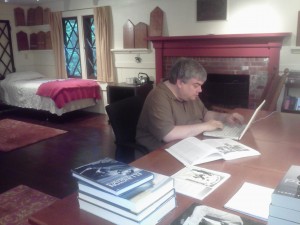 On the other hand, those first drafts were both subjected to months and months of painstaking revision, and in the case of Satchmo, I found it impossible to believe that a play whose first draft I had written so quickly could be any good. (I didn’t feel that way about The Letter, but that was because I was collaborating with an established composer who liked what I was doing.) So I sent Satchmo to a pair of professional stage directors whom I trusted to tell me the truth, both of whom said the same thing: It needs a lot of work, but you’ve definitely got something here. Don’t quit now. And I didn’t.
On the other hand, those first drafts were both subjected to months and months of painstaking revision, and in the case of Satchmo, I found it impossible to believe that a play whose first draft I had written so quickly could be any good. (I didn’t feel that way about The Letter, but that was because I was collaborating with an established composer who liked what I was doing.) So I sent Satchmo to a pair of professional stage directors whom I trusted to tell me the truth, both of whom said the same thing: It needs a lot of work, but you’ve definitely got something here. Don’t quit now. And I didn’t.
Only then did I come to grips with the hard truth of the theatrical axiom that plays aren’t written, they’re rewritten—and only then did Ira Glass’ words became fully relevant to my own experience. For the longer I worked on Satchmo, the more clearly I saw its flaws, and the more I doubted my ability to fix them. The only thing that kept me going was that once I’d spent a year polishing Satchmo, everyone who read the revised script wanted to produce it. Had I hit a blank wall of disapproval at that point, I probably would have succumbed to my nagging doubts and given up.
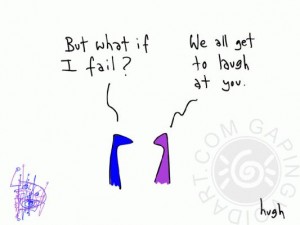 All this leads me to believe that Ira Glass’ observations about the relationship between taste and creative inhibition are the answer to the question of why so few drama critics try to write plays. If you’re a competent critic, then you’re painfully conscious of the yawning gap between “good” and “pretty good.” That knowledge can’t help but be inhibiting—especially when you earn your living by sitting in public judgment on the creative work of other writers. I didn’t need anybody to tell me (though they did) that a lot of people in the theater business would overflow with schadenfreude if Satchmo flopped.
All this leads me to believe that Ira Glass’ observations about the relationship between taste and creative inhibition are the answer to the question of why so few drama critics try to write plays. If you’re a competent critic, then you’re painfully conscious of the yawning gap between “good” and “pretty good.” That knowledge can’t help but be inhibiting—especially when you earn your living by sitting in public judgment on the creative work of other writers. I didn’t need anybody to tell me (though they did) that a lot of people in the theater business would overflow with schadenfreude if Satchmo flopped.
So what did I do? I worked even harder to make it better. I listened closely to the advice of Gordon Edelstein and John Douglas Thompson, the director and star of the Shakespeare & Company production of Satchmo at the Waldorf, and took virtually all of it. Inch by inch the gap closed, and by the time the play reached New York, it was what I wanted it to be. My skill had finally caught up with my taste.
I assure you, by the way, that I’m not bragging. I’m simply describing my own experience in order to encourage other people to try doing what I did—even those who are as old as I was when I started writing The Letter. For the moral of my story is that while it’s important to be realistic, both about your own abilities and, more generally, the larger prospects for success in the world of art, it can be just as important not to let yourself be overwhelmed by that realism.
As W.H. Auden wrote in his libretto for Benjamin Britten’s Paul Bunyan:
But once in a while the odd thing happens,
Once in a while the dream comes true,
And the whole pattern of life is altered,
Once in a while the moon turns blue.
No matter how old you are, you’re bucking shockingly long odds when you set out to write an opera or play or novel. It probably won’t be any good, and even if it is, it probably won’t be good enough. At the same time, what they say about state lotteries is equally relevant to creative work: you can’t win if you don’t play. If you do decide to play, you’ll have to work really, really hard. But if you put in enough hours at your desk—and if you’re lucky—then there’s a chance, slim but real, that you’ll produce a work of art of which you can be justly proud.
 Mrs. T and I were planning to go to Baltimore on Wednesday to see Center Stage’s revival of Amy Herzog’s 4000 Miles, the second installment of that company’s Herzog Festival. I’d already reviewed the first installment, After the Revolution, with exceptional enthusiasm, and was very much looking forward to finding out what Center Stage would do with the Herzog play that first made me aware of her great gifts. The imposition last night of a week-long ten-to-five curfew in Baltimore, however, persuaded me that it would be imprudent to try to see 4000 Miles any time soon.
Mrs. T and I were planning to go to Baltimore on Wednesday to see Center Stage’s revival of Amy Herzog’s 4000 Miles, the second installment of that company’s Herzog Festival. I’d already reviewed the first installment, After the Revolution, with exceptional enthusiasm, and was very much looking forward to finding out what Center Stage would do with the Herzog play that first made me aware of her great gifts. The imposition last night of a week-long ten-to-five curfew in Baltimore, however, persuaded me that it would be imprudent to try to see 4000 Miles any time soon.
I can count on the fingers of one hand the number of shows that I’ve been forced to skip in the twelve years that I’ve been reviewing theater for The Wall Street Journal. Bad weather stopped me from seeing most of them. This is the first time that a riot has forced me to stay home. I hope with all my heart that it’ll be the last.
Clinical depression really is a thing unto itself, qualitatively different from the milder mood disorders that are so frequently lumped together with it. Perhaps we do need a better word for clinical depression, something that more clearly suggests its devastating, incapacitating intensity….
Read the whole thing here.
 “It is undesirable to have a perfect taste, to respond properly to all the masterpieces. Unless we approach literature demandingly, as I say, unless we respect it for its influence, we fall into the attitude of the dilettante, the epicurean, on the style of the late Bernard Berenson, who by trying to prove that his taste was equal to the best that has been thought and said, made culture look like a table set with tidbits.”
“It is undesirable to have a perfect taste, to respond properly to all the masterpieces. Unless we approach literature demandingly, as I say, unless we respect it for its influence, we fall into the attitude of the dilettante, the epicurean, on the style of the late Bernard Berenson, who by trying to prove that his taste was equal to the best that has been thought and said, made culture look like a table set with tidbits.”
Alfred Kazin, “The Function of Criticism Today”
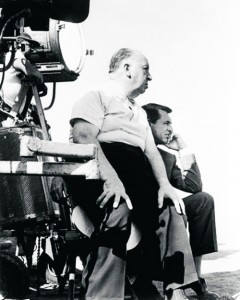 Mrs. T and I watched Alfred Hitchcock’s North by Northwest last week for the first time in a number of years. As we did so, I remembered that I’d written an essay about the film in 1998 for Civilization, a long-defunct magazine published by the Library of Congress. It’s never been collected or reprinted. I still like it, and thought you might feel the same way.
Mrs. T and I watched Alfred Hitchcock’s North by Northwest last week for the first time in a number of years. As we did so, I remembered that I’d written an essay about the film in 1998 for Civilization, a long-defunct magazine published by the Library of Congress. It’s never been collected or reprinted. I still like it, and thought you might feel the same way.
* * *
In 1952, the British film magazine Sight & Sound asked a group of noted critics and directors to pick the ten greatest films of all time. The exercise has since been repeated at decade-long intervals, and to compare the five lists published to date is to receive a priceless lesson in the evolution of taste. Some films appear regularly (Jean Renoir’s The Rules of the Game and Sergei Eisenstein’s Battleship Potemkin made all five lists), others only fleetingly (Luchino Visconti’s La Terra Trema appeared in ninth place in 1962, never to be seen again). About certain films, the consensus is clear: Citizen Kane, which failed to make the first list, shot to the top in 1962 and has been there ever since. Yet the ebb and flow of fashion are no less evident: Ingmar Bergman showed up in 1962 and 1972, Alfred Hitchcock in 1982 and 1992.
Hitchcock’s belated entry into the pantheon—three years after his death and 20 years after his last important film, The Birds—is among the more revealing aspects of the Canon According to Sight & Sound. For years, the maker of Psycho was generally regarded as a purveyor of cynical shockers unworthy of serious critical consideration. His colleagues, of course, knew him to be a consummate craftsman, but even they seem to have distrusted his artistry. How could a director whose movies were so blatantly lacking in what the U.S. Supreme Court used to call “redeeming social value” possibly belong in the same boat as Bergman or Renoir? And how could anyone take seriously the rotund jokester who exhaled “Goooodeeeeeve-ning” each week on TV, poking fun at himself (and his sponsors) to the mock-macabre accompaniment of Gounod’s Funeral March of a Marionette?
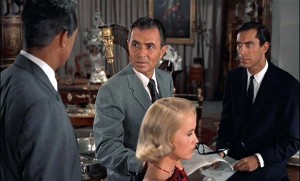 Today, Hitchcock is accepted as a great filmmaker, but the terms of his acceptance are narrowly framed: Vertigo is the only Hitchcock film ever to have made Sight & Sound’s top-ten list. Granted, Vertigo is a marvel, and surely one of his personal best—but why not North by Northwest, regarded by most Hitchcock buffs as a work of comparable stature? The two films, after all, sum up the two sides of his creative personality: James Stewart, the desperate lover of Vertigo, is perfectly balanced by Cary Grant, the supremely self-confident gent in a jam around whom the plot of North by Northwest swirls madly. Both films are technically dazzling; both have masterly scripts; both were scored by Bernard Herrmann, the film composer’s film composer. So what makes Vertigo the classic and North by Northwest the commercial?
Today, Hitchcock is accepted as a great filmmaker, but the terms of his acceptance are narrowly framed: Vertigo is the only Hitchcock film ever to have made Sight & Sound’s top-ten list. Granted, Vertigo is a marvel, and surely one of his personal best—but why not North by Northwest, regarded by most Hitchcock buffs as a work of comparable stature? The two films, after all, sum up the two sides of his creative personality: James Stewart, the desperate lover of Vertigo, is perfectly balanced by Cary Grant, the supremely self-confident gent in a jam around whom the plot of North by Northwest swirls madly. Both films are technically dazzling; both have masterly scripts; both were scored by Bernard Herrmann, the film composer’s film composer. So what makes Vertigo the classic and North by Northwest the commercial?
The answer is, alas, all too simple: North by Northwest is funny, and most critics don’t like funny movies. Or, rather, they don’t trust funny movies. Take another look at those Sight & Sound lists and you’ll notice that except for Buster Keaton’s The General and Charlie Chaplin’s City Lights, The Gold Rush, and Modern Times, all sanctified by their great age, the only Hollywood comedy ever to have been anointed is Singin’ in the Rain, which got the nod in 1982 but predictably failed to make the cut the next time around.
I sometimes wonder whether the reluctance of film professionals to acknowledge the artistic seriousness of comedy has something to do with the fact that their medium, popular though it is, has yet to be fully accepted as co-equal with what highbrows still persist in referring to as the “legitimate” theater. (Obviously, they haven’t been to Broadway lately.) As has lately been pointed out by Roger Ebert, there is no Pulitzer Prize for film, and the Nobel Prize for literature, though it has gone to playwrights often enough, has yet to be awarded to a full-time filmmaker. Could it be that the men and women who make the movies suffer from a collective inferiority complex? Could that be why they insist on awarding Best Picture Oscars to such bloated truckloads of pompous rubbish as Gandhi and Dances With Wolves?
If so, it would also explain why Alfred Hitchcock never received an Oscar for best direction—he simply wasn’t po-faced enough—and I suspect it also has much to do with the fact that North by Northwest, his finest and most characteristic movie, has yet to be widely recognized as such. Even those Hitchcock scholars who know how good it is feel obliged to swaddle their praise in a thick blanket of symbol-snuffling. Hence Donald Spoto, writing in The Art of Alfred Hitchcock, reassures us that North by Northwest “leavens the gravest concerns with a spiky and mature wit….Never has the entire hierarchy of unprincipled political expediency been so ruthlessly dissected.”
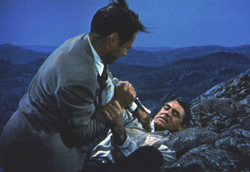 The only truly illuminating thing I’ve ever read about North by Northwest is a 1970 essay by the late Charles Thomas Samuels, who spoke admiringly of its “contentless virtuosity.” That’s exactly right, and it is for this reason that North by Northwest, which turns forty this year, has stayed as fresh as this morning’s paint. Here’s how Ernest Lehman, who wrote the script, pitched it to Hitchcock: “One day I said, ‘I want to do a Hitchcock picture to end all Hitchcock pictures, that’s the only kind of picture I want to do, Hitch.’ And by that I meant a movie-movie—with glamour, wit, excitement, movement, big scenes, a large canvas, innocent bystander caught up in great derring-do, in the Hitchcock manner.” To which the great man wistfully replied, “I’ve always wanted to do a chase sequence across the faces of Mount Rushmore.” And off they went, unencumbered by the faintest whiff of social consciousness, in search of thrills—and, just as important, laughs.
The only truly illuminating thing I’ve ever read about North by Northwest is a 1970 essay by the late Charles Thomas Samuels, who spoke admiringly of its “contentless virtuosity.” That’s exactly right, and it is for this reason that North by Northwest, which turns forty this year, has stayed as fresh as this morning’s paint. Here’s how Ernest Lehman, who wrote the script, pitched it to Hitchcock: “One day I said, ‘I want to do a Hitchcock picture to end all Hitchcock pictures, that’s the only kind of picture I want to do, Hitch.’ And by that I meant a movie-movie—with glamour, wit, excitement, movement, big scenes, a large canvas, innocent bystander caught up in great derring-do, in the Hitchcock manner.” To which the great man wistfully replied, “I’ve always wanted to do a chase sequence across the faces of Mount Rushmore.” And off they went, unencumbered by the faintest whiff of social consciousness, in search of thrills—and, just as important, laughs.
Nothing about North by Northwest is so memorable as its high-spirited humor, which is rooted in the casting of Cary Grant as Roger O. Thornhill, the suave advertising executive who ends up hanging by his eyelashes from George Washington’s nose. James Stewart had wanted to play the part, but Hitchcock knew he wasn’t right for it, and stalled until Stewart had to report for work on Bell, Book and Candle, making it possible to hire Grant without hurt feelings on either side. Seen in retrospect, it was the only possible choice, for Grant’s urbane presence is what gives the movie its special tone: even when he’s dodging a crop duster piloted by gun-toting Commie spies, you know he’s going to come out smelling like a dry-cleaned Brooks Brothers suit.
That, needless to say, is the whole point of North by Northwest. Though it pretends to be about the Cold War, it’s really about excitement, pure and simple: it has no more “content” than a roller-coaster ride. This is what Hitchcock had in mind when, midway through location shooting in New York, he said to Ernest Lehman, “Ernie, do you realize what we’re doing in this picture? The audience is like a great organ that you and I are playing. At one moment we play this note on them and get this reaction, and then we play that chord and they react that way. And someday we won’t even have to make a movie—there’ll be electrodes implanted in their brains, and we’ll just press different buttons and they’ll go ‘ooooh’ and ‘aaaah’ and we’ll frighten them, and make them laugh. Won’t that be wonderful?”
The only thing wrong with Hitchcock’s dream is that it came true, more or less. I have a sneaking suspicion that North by Northwest was the inspiration, acknowledged or not, for the decerebrate big-budget thrillers that blight the movie screens of America each summer. From Die Hard to Speed to ConAir, they’re all North by Northwest, only dumbed down, larded with four-letter words, and ruthlessly stripped of charm and wit. This is how far we’ve come since 1958: we started out with Cary Grant and ended up with Keanu Reeves. Yet it can hardly be denied that the first led to the second, for mindless thrills, be they cheap or costly, are still mindless thrills.
It is for this reason that any fully considered avowal of Hitchcock’s cinematic greatness must be followed by an asterisk. The trouble with Hitch isn’t that he is a comedian, but that his comedy is less black than blank. He avoids the jungle of politics by fleeing into the desert of nihilism, and while we gladly follow him there, there is no nourishment in his cold laughter, and never any tears. True comedy is different: I’ve never watched The Rules of the Game, or listened to Mozart’s Marriage of Figaro, without weeping unabashedly at the harsh truths about human nature that can only be spoken with an unsentimental smile.
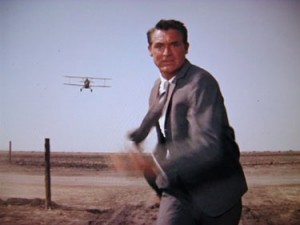 Still, there are many types of greatness, and Alfred Hitchcock’s kind, idiosyncratic though it is, makes the cut with room to spare. His best films are as watchable today as they were a half-century ago, and speak as directly to the case-hardened children of Generation X as they do to graying baby boomers like me. I recently invited a 23-year-old movie buff, raised on fast-moving indie flicks, to watch North by Northwest with me; she’d never seen it, and I wondered if Hitchcock’s carefully calculated pacing would strike her as arthritic. Not a chance. She watched in rapt silence as Cary Grant slithered drunkenly along the edge of a Long Island cliff, made out with Eva Marie Saint on the 20th-Century Limited (with kissing like that, who needs nude scenes?), and choked on clouds of DDT in a deserted prairie cornfield. “Cool!” she said at the end. “That is one totally cool movie.” And so it is, and ever shall be.
Still, there are many types of greatness, and Alfred Hitchcock’s kind, idiosyncratic though it is, makes the cut with room to spare. His best films are as watchable today as they were a half-century ago, and speak as directly to the case-hardened children of Generation X as they do to graying baby boomers like me. I recently invited a 23-year-old movie buff, raised on fast-moving indie flicks, to watch North by Northwest with me; she’d never seen it, and I wondered if Hitchcock’s carefully calculated pacing would strike her as arthritic. Not a chance. She watched in rapt silence as Cary Grant slithered drunkenly along the edge of a Long Island cliff, made out with Eva Marie Saint on the 20th-Century Limited (with kissing like that, who needs nude scenes?), and choked on clouds of DDT in a deserted prairie cornfield. “Cool!” she said at the end. “That is one totally cool movie.” And so it is, and ever shall be.
* * *
A Guided Tour With Alfred Hitchcock, a promotional short for North by Northwest:
 My essay in the May issue of Commentary is occasioned by the publication of Ted Gioia’s Love Songs: The Hidden History:
My essay in the May issue of Commentary is occasioned by the publication of Ted Gioia’s Love Songs: The Hidden History:
Most pop songs are about love. So are most classical art songs. So are most folk songs. What is more, most of us take all this for granted, though a moment’s consideration suggests that we ought instead to be surprised by it. Since the range of possibilities for human action extends far beyond the compass of love, sex, and marriage, why should the representation of these three activities have preoccupied songwriters of all kinds?
Ted Gioia, a music historian and sometime jazz pianist, addresses this question and others related to it in his latest book, Love Songs: The Hidden History. The third and last in a trilogy of studies of what he calls “functional songs” that also includes Work Songs and Healing Songs (both 2006), Love Songs is a cross-cultural and engrossingly wide-ranging history. Gioia’s overarching premise is that love songs, far from being “wimpy music, for emotional weaklings and sentimental fools,” are in fact “radical and disruptive” manifestations of humankind’s “growing sense of individualism and personal autonomy.”…
This is an interesting and compelling thesis, but it has to be said that Love Songs is a bit superficial in its treatment of certain aspects of its subject. For one thing, Gioia has given us a book about lyrics, not music. He has little to say about the specifically musical matters upon which one might have expected a trained musician to shed light. And Love Songs turns highly problematic when it engages with the present moment. Gioia rightly points out that the traditional romantic love song has lately ceased to be as central to American pop music as it still was well into the ’70s. For now, while the pop charts are laden with songs about love, that love is often rendered in an anti-romantic manner that is sharply at variance with how love was customarily portrayed during the golden age of American popular song. But Love Songs says little about the underlying reasons for this shift and fails altogether to consider the possibility that the changed tone of the “love” song might be directly reflective of the splintered culture from which it springs….
Read the whole thing here.
| M | T | W | T | F | S | S |
|---|---|---|---|---|---|---|
| 1 | 2 | 3 | 4 | |||
| 5 | 6 | 7 | 8 | 9 | 10 | 11 |
| 12 | 13 | 14 | 15 | 16 | 17 | 18 |
| 19 | 20 | 21 | 22 | 23 | 24 | 25 |
| 26 | 27 | 28 | 29 | 30 | 31 | |
An ArtsJournal Blog